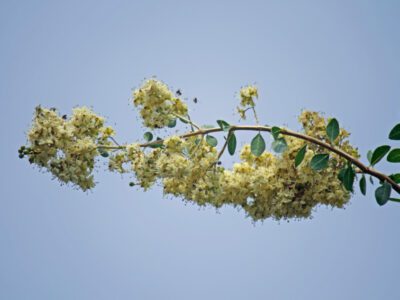Henna comes from the crushed leaves of the henna plant, scientifically known as Lawsonia inermis. Originating from the Middle East and North Africa, henna has a long history dating back thousands of years.
This natural dye has been used for various purposes, most notably in body art and hair coloring. The henna plant, known for its distinctive fragrant flowers, grows best in hot and arid climates. In these regions, it is closely associated with cultural and traditional practices, such as wedding ceremonies and religious festivals.
Henna powder is created by drying and grinding the leaves of the henna plant. When mixed with a liquid, such as water or lemon juice, this powder forms a paste that can be applied to the skin or hair. After a few hours, the paste is washed off, leaving behind a reddish-brown stain. This natural and temporary tattoo-like art form continues to captivate people around the world with its intricate designs and cultural significance.
Credit: en.wikipedia.org
History Of Henna
Henna, a natural dye used for centuries, has a rich history that spans ancient civilizations. Its origins can be traced back to Egypt, where it was used for body art, hair dye, and even mummification. In India, henna has been an integral part of weddings and festivals, symbolizing good luck and happiness.
In the Middle East, henna is a popular tradition during celebrations and religious events. Each region has its own unique designs and techniques, showcasing the cultural significance of henna. From intricate patterns to symbolic motifs, henna is more than just a temporary adornment – it is a form of expression and a way to connect with tradition.
Whether you’re admiring the delicate patterns on a bride’s hands or experimenting with henna designs yourself, this ancient art form continues to captivate and inspire.
Henna Plant And Harvesting
Henna, a natural dye, originates from the henna plant, which boasts unique botanical properties. The plant’s cultivation and harvesting techniques play a vital role in obtaining high-quality henna. Henna plants thrive in regions with warm climates, such as North Africa, the Middle East, and India.
These areas provide the perfect conditions for henna cultivation, resulting in a rich and vibrant dye. The henna plant itself features small leaves, and its size can range from a shrub to a small tree. Farmers carefully harvest the leaves, allowing them to dry and grind them into a fine powder.
This process ensures that the henna maintains its natural properties, making it suitable for various applications, including body art and hair dye. Whether you’re seeking a temporary tattoo or a natural hair coloring solution, henna offers a safe and organic option.
Henna Production And Processing
Henna, a natural dye commonly used for temporary body art and hair color, has a long history rooted in ancient cultures. Traditionally, henna production involved several manual processes, including grinding henna leaves into a fine powder and mixing it with water or other liquids to form a paste.
These methods ensured the preservation of the plant’s active ingredients. However, in recent years, modern techniques have emerged, utilizing machinery to enhance efficiency and quality control. These advancements involve mechanized grinding and sieving processes that produce finer henna powders. Moreover, factors like the quality of raw henna leaves, climate conditions during cultivation, and storage methods can impact the overall quality of the henna powder.
As henna continues to gain popularity worldwide, understanding its origins and production methods becomes increasingly important.
Henna Dye Extraction
Henna, a natural dye commonly used for body art and hair coloring, originates from the leaves of the henna plant. To extract the dye, a process called henna dye extraction is followed. The leaves are first dried and then crushed into a fine powder.
Natural ingredients such as lemon juice, tea, or coffee are then mixed with the henna powder to create a paste. This process allows the dye to release its color and become ready for application. Storing and aging the henna paste is crucial for achieving optimal results.
It is recommended to store the paste in a cool and dark place for at least 24 hours before applying. This allows the dye molecules to fully develop and intensify. By following these steps, one can enjoy the beautiful and lasting color that henna provides.
Henna Art And Application
Henna, a natural dye, has its origins in ancient cultures such as Egypt and India. This art form involves applying a paste made from henna leaves to the skin, creating intricate designs. Various styles and techniques of henna application exist, each with their own unique patterns and motifs.
The tools and materials used in henna art include cones, stencils, and essential oils, which contribute to the vibrant colors and longevity of the designs. Henna has deep cultural and ceremonial significance in many communities, often used for celebrations such as weddings and festivals.
Its application is seen as a form of adornment, symbolizing joy, beauty, and good luck. Whether it’s intricate bridal henna or simple everyday designs, henna art continues to captivate and inspire people around the world.
Henna In Beauty And Cosmetics Industry
Henna, a plant-derived dye, has gained growing popularity in the beauty and cosmetics industry. Known for its natural properties, henna is being widely used in various beauty treatments. One of its notable applications is as a hair dye, offering benefits such as conditioning and nourishing the hair.
Additionally, henna serves as an alternative to chemical-based cosmetics, providing a safer and healthier option for those seeking natural beauty products. With its rise in popularity, more and more people are turning to henna as a trusted ingredient in their beauty routines.
Its natural and versatile characteristics make it a preferred choice for those looking to enhance their beauty while also being mindful of their health and the environment. Whether it’s for coloring hair or replacing conventional cosmetics, henna has become a go-to option for many beauty enthusiasts.
Henna In Traditional Medicine
Henna, a natural dye derived from the Lawsonia inermis plant, has been used for centuries in traditional medicine across various cultures. Its healing properties and therapeutic uses make it a valuable ingredient in herbal remedies. Henna is believed to possess anti-inflammatory, antifungal, and antibacterial properties, making it effective in treating various skin conditions such as rashes, burns, and infections.
In addition, it is used as a natural hair conditioner and a soothing agent for the scalp. However, it is essential to consider the safety aspects and precautions associated with the medicinal use of henna. Allergic reactions may occur in some individuals, so a patch test is recommended before applying henna topically.
Furthermore, pregnant women and individuals with glucose-6-phosphate dehydrogenase deficiency should avoid henna due to potential complications. In conclusion, henna’s role in traditional medicine is a testament to its therapeutic potential.
Global Demand And Trade Of Henna
Henna, a natural dye derived from the henna plant, is cultivated in various countries across the globe. These countries serve as leading henna producers, catering to the high global demand for this ancient art form. Henna trade routes connect these nations to export markets worldwide, allowing for the distribution of henna products and supplies.
The economic impact of the henna industry is significant, providing livelihoods and income to local communities. The cultivation and trade of henna play a vital role in supporting these communities, boosting their economies and promoting cultural heritage. From intricate henna designs to the utilization of henna in various traditions and celebrations, this natural dye has transcended borders, leaving its mark on people’s lives around the world.
The Future Of Henna
Henna, a natural dye derived from the leaves of the henna plant, has a rich history that dates back thousands of years. Today, it is not only a popular form of body art, but also a key player in various emerging trends and innovations.
Sustainability and ethical considerations have become a priority in henna production, with efforts to ensure environmentally friendly practices and fair trade. Additionally, henna plays a significant role in promoting cultural diversity and heritage, as it is deeply rooted in various traditions around the world.
From intricate bridal designs to community celebrations, henna continues to captivate people with its beauty and symbolism. As the future unfolds, we can expect to see further developments and advancements in the way henna is used and appreciated across different cultures and societies.
Frequently Asked Questions On Where Does Henna Come From
Is Henna African Or Indian?
Henna is both African and Indian in origin.
Is Henna Arabic Or Indian?
Henna is both Arabic and Indian and is widely used in both cultures.
Why Is Henna Illegal In The Us?
Henna is not illegal in the US. However, certain synthetic henna products may be banned due to harmful chemicals.
Is Henna Religious Or Cultural?
Henna is both a cultural and religious practice.
Conclusion
Henna, a natural dye derived from the leaves of the henna plant, has a rich cultural history that dates back thousands of years. Originating in regions such as North Africa, the Middle East, and South Asia, henna has been used for centuries in traditional ceremonies and celebrations.
With its deep-red hues, henna has become synonymous with beauty, art, and self-expression. Its popularity has surged in recent years, transcending geographic borders to captivate individuals worldwide. This versatile plant has found its way into modern fashion and cosmetic industries, offering a safe and temporary alternative to synthetic dyes.
The demand for henna-based products, like henna tattoos and hair dyes, continues to grow, as people embrace the beauty of natural, plant-based options. So, next time you admire the intricate patterns of a henna design or enjoy the vibrant color of henna-dyed hair, remember the fascinating journey of this timeless cultural symbol that has united people across the globe.







